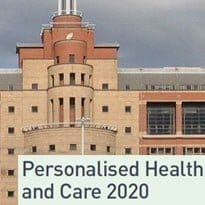The National Information Board has issued its much delayed IT strategy – ‘Personalised Health and Care 2020’ – which ties NHS IT more closely into health service policy, financial and regulatory frameworks.
As flagged by speakers at EHI Live 2014 in Birmingham last week, the strategy emphasises that it is “not a strategy in the conventional sense” and “not a national plan.”
Instead, the document put out by the NIB, which represents 20 health and local government organisations interested in IT, says it is a “framework for action that will support staff, patients and citizens to take advantage of the digital opportunity.”
The framework says the NHS must do this now because of the challenge laid out in the ‘Five Year Forward View’ issued by NHS England chief executive Simon Stevens to try and close the £30 billion gap between flat funding and rising demand that could otherwise open up by 2020-21.
It points out that the 5YFV identifies three gaps that need to be tackled – public health, quality of care, and efficiency – and argues that IT has a role to play in all three.
“To ensure sustainability, health and care needs to move from a model of late disease management to early health [promotion],” it says.
“Information technology plays an essential and rapidly expanding role in empowering people to take charge of their own health, by providing information, support and control.”
At the same time: “The introduction of new models of care that deliver better health and wellbeing outcomes for people, and a better experience when they access services, [requires] interoperable and flexible systems and locally championed innovation.
“By effectively harnessing technology to help reshape care delivery… we will drive down variations in quality and cost-effectiveness, while improving efficiency.”
The Personalised Health and Care 2020 framework goes on to set targets for IT to underpin specific NHS policies in these areas.
Reverting to one of the coalition government’s early ambitions, it says that from March 2018, individuals “will be enabled to view their care records and record their own comments and preferences… with access through multiple routes, including NHS Choices”.
More radically, it also says NHS England will pilot individual ‘care accounts’ that will not just hold records but the personal health and social care budgets being introduced as ‘integrated personal commissioning’ from April next year.
Other pledges for patients include a “single point of access to all transaction services”, again through NHS Choices, which will be integrated with NHS 111 “to create a seamless public information service”, a new system of “kitemarking” for apps, and a big expansion of patient feedback initiatives and social media monitoring.
When it comes to IT systems, or “giving care professionals the data they need”, the framework does not mention health secretary Jeremy Hunt’s call for a ‘paperless’ NHS by 2018.
However, it says that “all patient and care records will be digital, real-time and interoperable by 2020” and transitions between services will be made without records two years earlier.
It suggests this will be achieved with a stronger national lead on buying and standards. But in line with recent comments from NIB chair and NHS England director of patients and information Tim Kelsey, it also suggests that sticks will be applied, in the form of financial and regulatory action against trusts that fail to digitise.
In another section that underlines the new alignment between policy and IT, the framework also says that NHS England and Monitor will “develop data standards to support new costing, pricing and payment systems” to support the move towards new, integrated care models.
Other bodies will work on data standards to improve the timeliness and quality of NHS data. In line with the move towards encouraging regulators to take action on NHS IT, the CQC will include these data standards within its regulatory regime by April 2016.
In total, Personalising Health and Care 2020 has six sections, with additional discussions on rebuilding public trust in data use following the care.data debacle, encouraging innovation and growth, and ensuring best value for taxpayers.
Further detail on the sections and targets will be set out in a series of roadmaps that are due to be published over the next few months.

